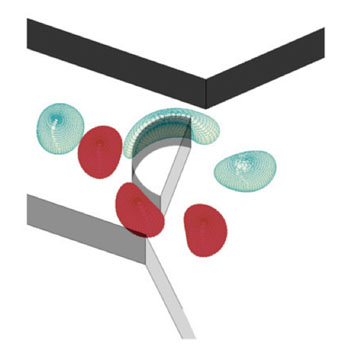Microfluidic Device Could Improve Biomarker Analyses
By LabMedica International staff writers
Posted on 08 Jul 2014
A new microfluidic device could offer a more reliable alternative for detecting biomarkers in patients facing such illnesses as cancer or malaria. Posted on 08 Jul 2014
The physical attributes of cells are important biomarkers in medicine, whether extracting circulating tumor cells from the blood of a cancer patient, or to measure the elasticity of red blood cells due to malaria infection.

Image: Visualization from a numerical simulation of a cell flowing past the obstacle through the microfluidic device (Image courtesy of KTH – The Royal Institute of Technology).
Scientists at The Royal Institute of Technology (KTH; Stockholm, Sweden) proposed a microfluidic device that can sort elastic capsules by their deformability. The device consists of a duct embedded with a semi-cylindrical obstacle, and a diffuser which further enhances the sorting capability. The KTH team used extensive computational simulations to model a microfluidic device that would sort cells according to their elasticity. The work draws on numerical techniques and computational capabilities developed in the last decade to handle the complexity of microscale flows.
Most cell sorting techniques rely on the difference between chemical properties of the cells. The problem is chemical properties do not give pathologists the full picture. Two cells can have very similar chemical properties, but different physical properties. Size, shape and elasticity, or deformability, are important attributes that can be also enable cell sorting, given the right kind of device.
The scientists demonstrated that the device can operate reasonably well under changes in the initial position of the capsule. The efficiency of the device remains essentially unaltered under small changes of the obstacle shape from semicircular to semi-elliptic cross-section. Confinement along the direction perpendicular to the plane of the device increases its efficiency. This work is the first numerical study of cell sorting by a realistic microfluidic device.
Dhrubaditya Mitra, PhD, an assistant professor in theoretical physics and a coauthor of the study offers an example of why elasticity matters. “If you are infected with malaria, the physical nature of your red blood cells changes. They become harder and red blood cells also become harder as they get older too. These harder red blood cells are filtered by the spleen which acts like a sieve. The softer red blood cells can squeeze through the gaps but the harder ones cannot.” The study was published on June 20, 2014, in the journal Soft Matter.
Related Links:
The Royal Institute of Technology













